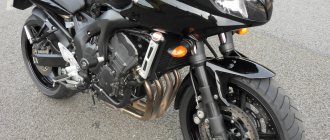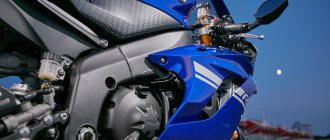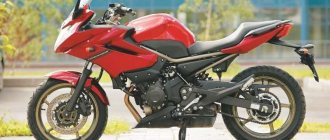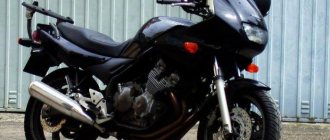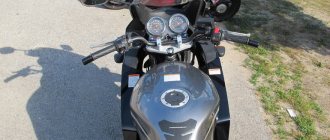Appearing in parallel with sabotage 400, in 1992 Yamaha diversion xj 600 s was sent directly to export markets. In the final set it is saved her. If 400 lived only a few years, the model is 600 cm3, released within 10 years. It received 1 restyling, and one modification was released on its basis. The last bike will leave the assembly line in 2002.
Later in 2009, the model received a successor, the Yamaha XJ6 Diversion. It has been in production for 8 years , and in 2017 it also closes.
Specifications
One of the ideas for the 600 was budget, so it was considered inappropriate to develop a new motor.
Therefore, the bike was based on a conventional 4-stroke engine with 4 cylinders with in-line pistons and air cooling.
Engine – left view.
Engine – right side view.
Carburetor – 4x Mikuni BDS28.
It is curious that for 400 they used the same option with similar settings , only adjusted for the reduced volume.
Transmission and clutch
The “Diva,” as its owners lovingly called it, was equipped with a 6-speed gearbox .
The owners are happy .
You can drive according to the standard, clicking the gears as needed, clicking everything at once, and then use the throttle, or drive in first. It all depends on the user's preferences. They note that on a cold engine, the clutch can switch quite noisily. The box does not cause any other complaints.
The main drive, as standard, is a chain .
Brakes
Front brakes.
Rear brakes.
According to user reviews, the brakes are excellent . There were previous complaints about models before 1998 2 discs , which solved all the problems. It is curious that the original 1 disk had a diameter of 320 mm . The pair of discs have diameters of 298 mm . At the rear there is also 1 disc with a diameter of 245 mm .
Support is based on a 2-piston caliper for the front wheel, 1-piston for the rear
No additional systems.
General advantages compared to similar motorcycles
Now that we’ve sorted out the technical characteristics, it’s time to summarize the cherished advantages of this model, confirmed by reviews. And they are as follows:
- Conveniently located switches, easy-to-use dashboard.
- On city roads and good highways, a comfortable bike ride is guaranteed.
- The motorcycle is easy to operate, predictable in behavior and amenable to complete control even in the most unexpected situations.
- Operation is simple for all categories of drivers.
- The seat is comfortable for long bike rides.
- The motorcycle is universal when choosing relative to the road surface.
- Optimal fairing system and stylish expensive design.
Driving performance
The maximum speed indicated in the documentation is 188 km/h . The owners say that the mark is achieved effortlessly, and if you switch to 6th gear, you can do more. Comfortable cruiser - 100–120 km/h .
Acceleration (dynamics)
Acceleration from zero to 100 km in 4.8 seconds.
Measured using GPS . It was noticed that the N modification can do 4.2, but for a road bike, which includes all split-second diversions, as a rule “they don’t make a difference.”
Yamaha design: as always in its splendor
The body of the Yamaha Diversion 600 was enlarged, resulting in a large and comfortable seat, which is important for long rides. Both the mirrors and the panel board are located as much as possible for the driver of the bike, and the ergonomics themselves are excellent. The ride quality of the motorcycle allows you to feel great both in a big busy city and on a breathtaking ride on the highway. The braking system is balanced and makes it possible to accelerate and brake effectively even in the most unexpected situations, which adds a definite plus to safety. But the most important innovation is that now the Yamaha Diversion has begun to look larger and more massive: it is for this quality that experienced motorcyclists choose. Yes, with such a model it can sometimes be inconvenient in traffic jams around the city, but the external solidity and internal characteristics more than make up for this drawback.
As for her appearance, she also managed to stand out with a variety of colors: green, black, red, blue, silver-gray, purple, burgundy, yolk. Over time, a color scheme in a stylish metallic shade was added to the model: now the Yamaha Diversion 600 motorcycle has become noticeable on the road from afar. The developers chose non-standard colors after each change and improvement of the bike in accordance with the reaction of regular customers. The Yamaha Diversion 600 is a low-slung, lightweight and compact motorcycle: such features contribute to good streamlining, which significantly improves maneuverability in various situations on the roads.
Modifications
Yamaha XJ600N is a naked modification with a round headlight without a plastic fairing.
Since 1994, motorcycle production has been divided into 2 modifications.
- Yamaha Diversion XJ 600 S - basic and basic version with windshield;
- Yamaha XJ600N - naked version. In terms of the filling, everything is the same, there is no front half-fairing, therefore, no windshield.
Some confusion between the variations was also caused by the fact that the second version does not have its own name. Because of this, it was often separated into a separate model. It is curious that later, with the revival of sabotage, confusion remained . The new naked bike did not receive a proper name either.
and competitors
Honda SV600.
Suzuki GSF 600 Bandit.
Kawasaki GPZ 500.
In response to the release of this version, other members of Japan's Big Four offered their responses.
Honda came up with the legendary Hornet, model CB600, although it later offered another motorcycle - the Honda CBF 600;
Other representatives were not so prolific, offering only one version for comparison.
- For Suzuki it was the GSF 600 Bandit.
- Kawasaki offered the GPZ 500 . An interesting solution, smaller engine capacity, less torque, but at the same time, due to boost, comparable speed and dynamics.
Brief history of the model
1992 - start of production and sales of the model. Model: Yamaha Diversion 600 / Seca II (Europe, North America). Factory designation: 4BR1, 4BR2, 4DG1, 4DS1, 4DU3, 4EB1.
1993 - no significant changes. Model: Yamaha Diversion 600 / Seca II (Europe, North America, Japan). Factory designation: 4BR3, 4BR4, 4DG2, 4DS2, 4HK1, 4EB2.
1994 - appearance of the naked modification. Model: Yamaha Diversion 600 / Seca II; Yamaha Diversion 600 (Naked) (Europe, North America, Oceania). Factory designation: 4BR6, 4BR7, 4DG4, 4EB4, 4KA1, 4KE1, 4KE2, 4KF1, 4LX1, 4MB1.
1995 - no significant changes. Model: Yamaha Diversion 600 / Seca II; Yamaha Diversion 600 (Naked) (Europe, North America). Factory designation: 4BR8, 4BR9, 4DG5, 4DUC, 4EB5, 4KA2, 4KE3, 4KE4, 4KF2, 4LX2, 4MB2.
1996 - no significant changes. Model: Yamaha Diversion 600 / Seca II; Yamaha Diversion 600 (Naked) (Europe, North America). Factory designation: 4BRA, 4DG6, 4DUF, 4EB6, 4KA3, 4KE5, 4KE6, 4KF3, 4LX3, 4MB3.
1997 - no significant changes. Model: Yamaha Diversion 600 / Seca II; Yamaha Diversion 600 (Naked) (Europe, North America). Factory designation: 4BRC, 4BRD, 4DG7, 4EB7, 4KA4, 4KE7, 4LX4, 4MB4.
1998 - restyling of the model. The model receives an increased thickness fork (38 → 41 mm), a 2-disc front brake (instead of a single disc), an oil cooler and new versions of carburetors. Model: Yamaha Diversion 600 / Seca II; Yamaha Diversion 600 (Naked) (Europe, North America). Factory designation: 4BRE, 4DG8, 4EB8, 4KA5, 4KE9, 4KF5, 4LX5, 4MB5.
1999 - no significant changes. Model: Yamaha Diversion 600; Yamaha Diversion 600 (Naked) (Europe). Factory designation: 4BRF, 4DG9, 4EB9, 4KA6, 4KEA, 4KF6, 4LX6, 4MB6.
2000 - no significant changes. Model: Yamaha Diversion 600; Yamaha Diversion 600 (Naked) (Europe). Factory designation: 4BRG, 4DGA, 4KEB, 4KF7, 4LX7, 4MB7.
2001 - no significant changes. Model: Yamaha Diversion 600; Yamaha Diversion 600 (Naked) (Europe). Factory designation: 4BRH, 4DGB, 4KEC, 4KF8, 4LX8, 4MB8.
2002 is the last year of production. Model: Yamaha Diversion 600; Yamaha Diversion 600 (Naked) (Europe). Factory designation: 4BRJ, 4DGC, 4KED, 4KF9, 4LX9, 4MB9.
Peculiarities
The Yamaha XJ 600 S Diversion is a road bike that is equally well suited for both experienced and novice pilots.
The motorcycle has few distinctive features, and some users consider some of them to be advantages, others to consider them disadvantages.
- Ergonomics . A comfortable large sofa for both the motorcyclist and the passenger, ideally calculated height and inclination of the mirrors and instrument panel.
- Good handling , convenient for shooting between rows.
- Excellent maneuverability.
- Gripping brakes.
- Cost - at the time of release, new, it cost about the same as a well-used 400.
And there is also good traction at any speed. “You can already drive at 1500 rpm, according to reviews.”
Differences from similar motorcycles from other companies
What makes the Yamaha Diversion 600 special? The answer is this: the developers sought to bring to life the most comfortable qualities for driving and controlling a motorcycle. The model was modernized with newfangled inclusions - a cunning headlight with a “side size” star in the forehead, “turn signals” placed along with the number at a respectable distance from the “tail”, and especially a newfangled exhaust under the “belly”. The high-strength steel tube from which the diamond-shaped frame is constructed provides a balance of lateral stiffness, thereby increasing the very smoothness of cornering. The chassis of the Yamaha Diversion 600 has a modern design, narrow, compact, impressive with its convenience and lightness, which is important for driving motorbikes in large cities with narrow streets.
From the point of view of a typical buyer of such equipment, who does not need adrenaline in a bunch of turns, but the ability to get to a place as safely as possible and with minimal fatigue, this type of bike will be ideal for him. The rigidity of the system is not lower than before, but we also tinkered with comfort, reconfiguring the suspension and increasing the fork angle at the same base. It is also worth noting that Yamaha Diversion motorcycles are suitable for both beginners and experienced, seasoned bikers. The tubular frame has significantly reduced the dimensions of the bike and its weight, which makes it possible to steadily adhere to a given trajectory. A motorcyclist of average to short stature can easily touch the ground with his feet at low speeds when maneuvering. The instrument panel contains a modern analog tachometer, as well as a functional monitor with a speedometer. This model is equipped with a tachometer needle with a luminescent coating and LED illumination of the main panel, which makes it easy to monitor the situation even at night. And this is not the least important point when choosing a future purchase.
Produced in three colors:
- Extreme Yellow.
- Midnight Black.
- Cloudy White.
Yamaha has also developed a huge number of accessories for this model for comfortable travel at any distance. The compact motorcycle "Yamaha Diversion-600" is easy to ride. An important role in describing the advantages of “Diversion” is played by a very stylish external appearance, which, combined with Japanese capitalism and the absence of significant disadvantages, makes the model attractive to a wide audience.
Reviews from owners about the Yamaha Diversion 600 bike are not very enthusiastic, although generally positive. Unfortunately, a large man is somewhat uncomfortable behind the wheel and still needs to try to look in the rearview mirrors. For spoiled motorcyclists, it seems too predictable and calm, although for a beginner this is sometimes worth a lot. There are very different opinions about traveling long distances. Some are wildly delighted, and some are dissatisfied with the fact that the seat is too thin and too hard for them to go on a long journey with pleasure and comfort.
Power point
For the lightweight Yamaha XJ6 motorcycle, the characteristics of the upgraded engine are perfectly suited.
The displacement of the four-stroke in-line four-cylinder liquid-cooled engine is 600 cc. The unit develops a maximum power of 78 hp. (57 kW) at 10 thousand rpm, and the maximum torque is 59.7 Nm at 8.5 thousand rpm.
The cylinders are inclined forward, each of them has four valves, camshafts, and there are two of them, overhead. The newly designed cylinder head allows for a higher compression ratio. Intake ports have been reduced. To increase rigidity, the upper half of the crankcase is made as a single unit with the cylinder block.
The camshaft cam profile is designed to provide high torque at low and medium crankshaft speeds.
To reduce the weight of the motorcycle, the pistons are forged aluminum.
The fuel injection system has dual-directional four-port fuel injectors.
The muffler of the exhaust system, the configuration of which is “4-1”, is located under the frame. It is equipped with an oxygen sensor and a three-way catalytic converter.
And this is not all the features of the engine system of the Yamaha XJ6 motorcycle.
Front fork
General information:
- The diameter of the fork leg is 41 mm.
; - The oil used is Suspension oil 01 Yamaha with a viscosity of 5w
in each leg of
473 cm3
(about one liter of oil is needed to repair the entire fork); - Fork seal size: 41x53x11 mm.
; - Fork spring length: 365.1 mm
.
Original spare parts:
- Oil seal, one per package: 5VU-23145-00-00
(Normal price - $11). - Boot, one per package: 3VD-23144-00-00
(Normal price - $15). - Upper fork guide: 3VD-23125-10-00
(Normal price - $14) - Lower fork guide: 3VD-23135-10-00
(Normal price - $11)
Analogues from All Balls Racing:
- All Balls 56-156
boot and seal kit (two boots, two seals in the box) - $28 - Oil seals only (2 pieces per box) All Balls 55-116
- $14 - Anthers only (2 pieces per box) All Balls 57-143
— $15
There are nuances
“On narrow serpentines, the Kawasaki beats the Yamaha thanks to more precise control”
The engines of both motorcycles are characterized by smooth torque transmission. You can calmly reduce the revs to 2000 in sixth gear, and then smoothly give the gas and move on without any jerks. The ER-6f and Diversion engines are different in format, but similar in character: all the “fat” is in the middle speed range. Kawasaki also has 50 cm3 of additional volume, so it’s even easier for engineers to squeeze a smooth torque curve out of it. The price for the claimed 66 Nm at 7000 rpm is a higher level of vibrations, which are not a concern in the city, but begin to annoy during a long trip on the highway. According to this indicator, sabotage looks better than its competitor. In mixed driving, the ER-6f scores higher points thanks to its sportier riding position and stiffer front suspension for confident cornering. Moreover, the fork of the version with the ABS system is configured more rigidly than that of the version without it. As a result, the suspension transfers even small surface irregularities to the rider’s hands. The Kawasaki has a real riding advantage when the asphalt is smooth. If the surface is not at all like a billiard table, the front suspension of the Diversion works better and provides a good feeling of the road.
"1. The instrument panel of the Diversion is similar to those installed on the FZ1 and FZ6: easy to read and informative 2. Only the brake lever can be adjusted 3. The monoshock absorber is adjusted only by spring preload 4. The muffler is located at the bottom and is carefully hidden in the depths of the central stand. Rubber pads remove vibrations from the rider’s and passenger’s footpegs 5. The presence of a central stand is a pleasant Yamaha touring bonus 6. The rear 245 mm disc is equipped with a 1-piston caliper.”
As for the factory settings of the monoshock absorbers, here too the Kawasaki turns out to be stiffer, which is very useful for sudden changes in direction of movement. The rear suspension of the Diversion is more comfortable. This is expressed in some swings at the exit of the turn. All this can be partially eliminated by adjusting the spring preload, which is done with a key on both motorcycles. Convenient knobs for instantly adjusting the suspension would be very useful here. And finally, about the brakes. The diversion is equipped with a powerful and informative braking system, in which ABS is truly an option, and not an absolute necessity. By the way, in some markets the optional ABS is not available. The ER-6f brakes no worse than the Diversion, however, the motorcycle we tested is equipped with ABS (the version without anti-lock braking system costs 500 euros less).
TEST DRIVE: Yamaha XJ6 and XJ6 Diversion (2009) – Anti-sabotage
Diversion, like Vmax, is a ghost from the 80s, revived by Yamaha in 2009. After years of the FZ6 dominating the Japanese 'entry level' 4-cylinder motorcycle lineup, the time has come for the XJ6 to make a comeback! Its element is a comfortable, leisurely ride, less power, but more torque at the bottom, and most importantly - affordable.
MOTOGONKI.RU, January 23, 2009 - After Honda released its most friendly CBF600, Yamaha decided to do the same, but with the help of the new XJ6 series. The motorcycle concept is identical to the original Diversion from the 80s and 90s, but with completely new features. The XJ6 and XJ6 Diversion are positioned as entry-level motorcycles to make the difference between the R6 and FZ6 even clearer. The current version of the FZ6 with an engine power of about 100 hp. It’s getting closer and closer to the “R-ke”, although not the refined sportbike that we have now, but its previous concept from 2006.
The XJ6 differs in several key ways, such as a detuned inline-bar similar to the FZ6, a new, lightweight chassis and completely different ergonomics. Everything has been done to ensure maximum ease of mastering the motorcycle for future “saboteurs.”
It's really easy to ride. Immediately after pressing “Start”, the XJ6, humming softly, carried me away from the bustle of Sydney city streets. The engine characteristics are very reminiscent of the Honda CBF600, which is built on the basis of a 78-horsepower engine (maximum power is achieved at 10,000 rpm) with 60Nm of torque somewhere around 8,500 rpm.
“Somewhere” means that these little 600cc fours are naturally revving. However, the XJ6 delivers peak torque 1,500 rpm earlier than its souped-up FZ6 sibling. This also means the XJ is easier to get going, starting almost from idle. The XJ6 feels much more capable in lower gears than the Honda. The last time I rode the CBF600 I was left with the impression of a much softer and heavier bike than the Yamaha. The specification confirmed the guess: the XJ is 8 kg lighter.
It took me about a minute to master the control panel, so I spent the rest of the time exploring the beautiful Australian city and its surroundings. Everything from the clutch hydraulics to the gearbox is softened to the limit. Nothing that could in any way be associated with its aggressive headlights. This is important for those who have just begun to get acquainted with the world of motorcycles, as well as for slender people, for girls, finally!
The first impressions of the XJ6, seen in the hotel lobby, were correct: in terms of the level of finishing and materials, this is a budget motorcycle, but its price is 100% justified, unlike some competitors. This is without a doubt a city bike, because traveling on it, as the test showed, is not so comfortable.
We were advised to go straight to the Pacific Highway, a large road in all respects. But I took a detour to maximize my test mileage. I set off through the bush on excellent bypass roads, only to return to Sydney on this expressway. I was not mistaken. The suspensions on the XJ6 are not perfect, they cost exactly what they look like - budget. 205 kilos of dry weight for a “six hundred” is also not the ultimate dream. The tubular steel frame is great for the design of a bike like this, but those extra pounds feel a lot different than the FZ6's aluminum 'diagonal'. The lack of responsiveness from the suspension will disappoint an experienced pilot. But why need such subtle feedback on a bike designed for riding to the bakery? The XJ6 and XJ6 Diversion have everything for a comfortable ride on decently surfaced asphalt roads, and nothing more.
One little thing that I want to pay special attention to: the 160 rear tire is one of Yamaha's tricks in the virtual fight against dry weight. The bike easily turns and maneuvers in the bustle of the city.
The XJ6 Diversion differs from its XJ6 brother in only one way - the semi-fairing. The plastic is well thought out, looks good, no jambs or cracks at low tide. This is a good addition for those riders who plan to significantly expand their experience with small outings outside the city. Some people think that a plastic-clad bike looks bulky and heavy than a naked bike. The main difference between them is only a small wind protection and the location of the mirrors (on Diversion they are placed much wider - this is good for touring). I also liked the mirrors on the naked bike. We must pay tribute that vibrations are not transmitted to them at all, unlike the same Ducati Monster. Some high-frequency vibrations begin to be felt after a few hours in the saddle - on both footpegs and handlebars. I only noticed later that they appeared exactly at the moment when I thought about it. Well, if I didn’t pay attention to them all the way, then I shouldn’t even now.
But what started to bother me after a few miles was the seat. This is some kind of punishment for a discharged tourist! The seat is so thin that the suburbs of Sydney had not yet disappeared from view, and my butt began to ache. The very low position of the seat also played a role: in it I seemed very large and awkward. The running boards grabbed the asphalt with every turn, and I had to move further and further back towards the passenger seat. It seems that Yamaha is deliberately leaving a wide field for aftermarket parts manufacturers to operate!
Returning to Sydney, we could not pass by an incredibly beautiful place near the Harbor Bridge; the place turned out to be very popular - a certain local landmark, popularly nicknamed simply “The Hanger”. The entire range of biker stunts was performed in front of the photographers. By the way, the classic Wheelie “from gas” is available to XJ6 owners, but you will have to work on the trick if you want to raise the wheel above 10 cm.
The instrumentation is identical for both models and is easy to read. Digital speedometer on the left console and analog tachometer on the right. Both X-Js can be equipped with ABS for an additional $485. At the launch we were told that the UK MSRP would be £4,499 for the naked and £4,949 for the Diversion. In Russia, prices for “sabotage” are slightly higher - 318,900 and 323,300 rubles according to data from dealers as of December 2008.
In total
, Yamaha successfully fills the gaps in the model range, and overall, based on the test results, I think that both motorcycles, the XJ6 and XJ6 Diversion, are completely worth the price. The motorcycle looks much more expensive than it actually costs, and this fits well with the realities of the market. When you get tired of your XJ6 after a couple of seasons, it will quickly find a new owner on some motorcycle forum. The only unpleasant moment in my memory was the seat, too thin for long trips. Yamaha is bringing back the classic “Diversion”, an example of an inexpensive bike for every day, and this is good news against the backdrop of everything that is happening in the world today.
+ Good price/quality ratio + Easy to figure out how to use this engine, everything is accessible + Excellent control ergonomics + Excellent alternative as a city bike for every day
— Too thin, hard seat — Once the honeymoon is over, the XJ6 will quickly get boring
Tor Sagen, especially for MOTOGONKI.RU
Photos: Dentsu live
Optional equipment
The manufacturer has developed a lot of additional equipment and accessories for this model. Almost all of them are aimed at making travel on this motorcycle more comfortable, especially when it comes to long trips. Provided:
- Protective bars for the driver.
- Engine protection.
- Special linings for the fuel tank.
- Tank bag.
- Central stand.
- The top case has a volume of almost (40 liters and 50 liters). The case is equipped with a backrest and an internal bag.
- Aluminum trunk.
This is not a complete list of “extras”; we have listed only the main accessories that are relevant for long trips.
